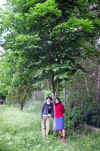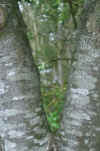Aspecto.- Árbol de
hoja caduca (normalmente de 15-25 m de altura, aunque algunos ejemplares pueden
alcanzar los 30 metros. Las ramas mas bajas son caídas
con el final de las mismas revuelto hacia arriba. Corteza castaño-rojiza
o grisacea, que se desprende en escamas, cuando son jóvenes están cubiertas de
borra de color ferruginoso.
Aspect.
- Deciduous
tree, (commonly 15-25
m. tall, but 30 m. specimens are
possibl). Lower branches hang down with branch tips turning upward. Chestnut
tree-reddish or grizzly bark that comes off in flakes, when they are young, are
covered with down of ferruginous color.
Hojas. – Son verde oscuro por el haz y más pálidas por el envés,
opuestas, palmeado compuestas de unos 10-25 cm de largo y 5-15 cm de ancho,
normalmente tienen 7 hojas con el borde irregularmente dentado, pero también
pueden tener de 5-9 hojas de 2,5 – 5 cm de longitud, permanecen en el árbol
hasta el otoño. Tienen peciolos tan largos como la hoja (10-25 cm). Las yemas
son grandes y están impregnadas de resina,
con escamas pardo rojizas.
Leaves.-
Leaves dark
green above and paler below, opposite, palmately compound, each 10-25 cm long,
5-13 cm wide, usually 7 but
sometimes (5-9) serrate leaflets (2,2 a 5 cm long), held late into fall.
Petioles are as long as leaflets. Buds large, 6-19 mm. and varnished with a
sticky gum with reddish brown flakes.
Flores.- Blanco cremosas, con manchas de colores amarillentos,
rosadas o rojizas, aparecen en vistosos racimos derechos de 10-30 cm (panículos)
en mayo. Tienen 4 o 5 pétalos
desiguales, con 7 estambres desiguales con filamentos arqueados.
Flowers.
– Creamy white
flowers, with a blotch of color yellowish, rosy or reddish, borne in a large
showy upright cluster 10-30 cm (panicles) in May. They have 4 or 5 unequal
petals, with 7 unequal stamens with arched filaments.
Fruto.
- Casi redondo y gruesos,
tienen una cáscara correosa con muchas espinas flexibles que encierran a (1-3)
castañas (semillas) lisas y dark brown. Se abre por tres valvas a finales del
verano y otoño.
Fruit.-
Spiny fruit,
about 25 cm diam, matures in early fall. Nearly
round with thick, leathery with flexible spiny husks enclosing 1 to 3 smooth,
chestnut brown seeds. Its opens up for three valves at the end of the summer and
autumn.
Habitat
y aplicaciones. - Tolera bien el sol o sombra pero con buena luz, quiere
suelos bien drenados, se adapta bastante bien a diferentes Ph y no tolera
situaciones de extrema sequía. El fruto no es comestible y se considera tóxico.
El amargor que tienen evitan que se puedan confundirse y comerse en cantidad. El
tóxico constituye entre el 3-5% de la semilla y es una mezcla de saponinas. Se
utilizan medicinalmente las semillas y corteza, como vasoconstrictor
antiinflamatorio y astringente.
Habitat
and applications.- Sun
or light shade, well-drained soil, pH adaptable, avoid extremely dry situations.
The fruit are inedible and are considered poisonous. The
fruit's bitter taste prevents the consumption of large amounts. The
toxic constituents amount to 3-5% of the seed and are a mixture of saponins. The
seeds and bark are used medicinally, as anti-inflammatory, astringent and
vasoconstrictor.
VOLVER




